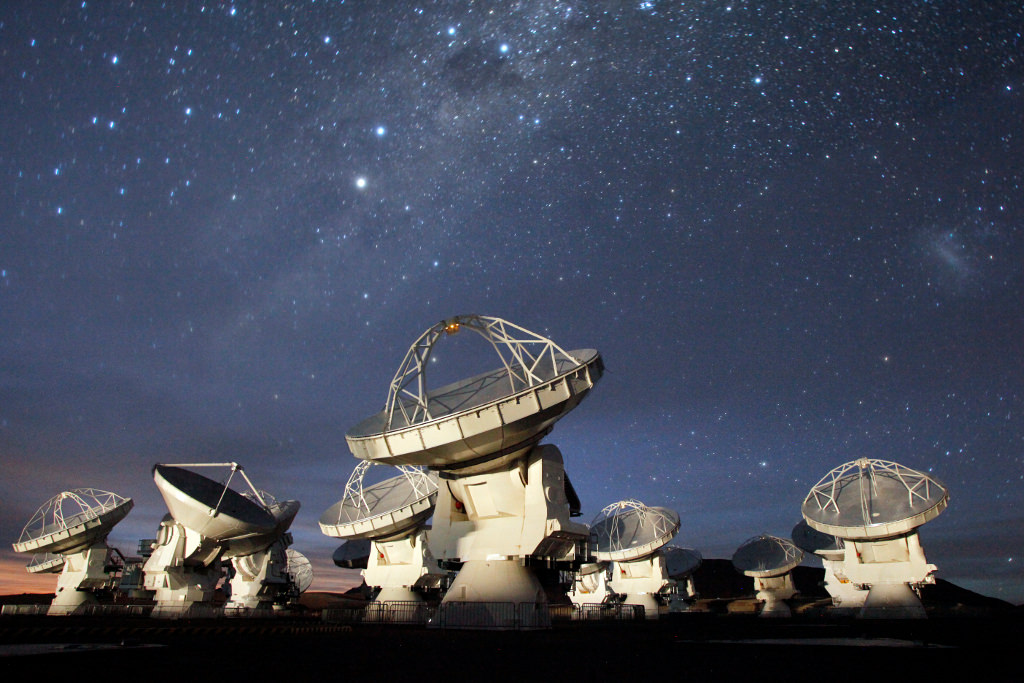Talk about an assembly line! Some early-stage galaxies created stars thousands of times faster than our Milky Way does today, according to new research. And it’s puzzling astronomers.
“We want to understand how and why these galaxies are forming stars at such incredibly fast rates, so soon after the Big Bang,” stated Scott Chapman of Dalhousie University, one of the researchers behind the discovery. “This could partially answer how our own galaxy, the Milky Way, was born billions of years ago.”
This is just a hint of the high-definition view we’ll receive from Chile’s Atacama Large Millimeter/submillimeter Array (ALMA), its astronomers promise, since the array of dozens of telescopes was officially inaugurated this spring. (ALMA has been working for years, but slowly adding telescopes and definition as it goes.)
There were actually three papers released today about ALMA. So what did the observatory find out this time? Here’s the nut graf:

– The observed galaxies are “gravitationally lensed”. Galaxies are so massive that they can bend light from other galaxies, if put in the right spot with respect to Earth. We’ve seen this effect over and over again with the Hubble Space Telescope, but observations are less well-known in the millimeter spectrum of light in which ALMA observes. “Models of lens geometries in the sample indicate that the background objects are ultra-luminous infrared galaxies, powered by extreme bursts of star formation,” stated a Nature paper on the discovery.
– These galaxies are further away than we thought. By measuring the time it takes light from carbon monoxide molecules to reach us, the astronomers concluded these galaxies are much further away than previously measured, with some reaching as far back as 12 billion light-years away. (That’s just 1.7 billion years after the Big Bang created the universe.)
– The galaxies put star creation on fast-forward. Looking back that far is like looking in a time machine — we can see things that were happening only 1 billion years after the Big Bang. At the time, those galaxies were as bright as 40 trillion suns and created new stars at an extreme rate of 4,000 suns per year. (That, by the way, is 4,000 times faster than what our own galaxy does.)
You can read more about these results in Nature and the Astrophysical Journal (here and here.)


Ha, just microwaved some popcorn earlier for the kids, and now I read about early galaxies churning out 4,000 stars year! Fitting somehow.
I wonder what our narrative will be next century, or even next millennium?
I though they still do in a slower way. I was not there to witness it.
As the universe expands it becomes colder, which means the energy of systems on average becomes lower. Energy and time are conjugate to each other so that as energy declines the periodicity or time scale of systems increases. During the earliest universe fundamental events occurred on 10^{-30}sec time scales and even smaller. The same holds with galaxy evolution and star formation. They produced lots of stars early on, but that rate has declined as galaxies matured. Mergers provide a burst of star forming activity, but in the long run galaxies will become populated by red dwarf stars that form very slowly, exist for long times at cooler low luminosities, and die out as cold bodies of helium gas. in 10^{12} years it will all be pretty much over. The universe will though continue for 10^{100} years to wind down to thermal heat death, with a far vaster time period beyond leading to quantum death.
The future of the universe in the long run has that Pink Floyd “things are winding down” and “you can’t win” element to it.
LC
Thank you for your reply and knowledge. I did not give red dwarfs much thought in that way. What about the brown dwarfs.Are they as many? I often get the types of stars confused and their lived lives.
PS: great choice with “Pink Floyd”. I know the band and their jamms so very well. I had “things winding down” playing in my head instantly as I read it. Nothing like “classic rock & roll” to stimulate a baby boomers mind. :-)…
Links to (free) preprints of the papers mentioned in the article:
“Dusty starburst galaxies in the early Universe as revealed by gravitational lensing”: http://arxiv.org/abs/1303.2723
“ALMA Observations of SPT-Discovered, Strongly Lensed, Dusty, Star-Forming Galaxies”: http://arxiv.org/abs/1303.2722
“ALMA redshifts of millimeter-selected galaxies from the SPT survey: The redshift distribution of dusty star-forming galaxies”: http://arxiv.org/abs/1303.2726